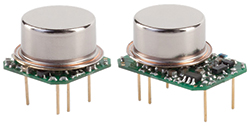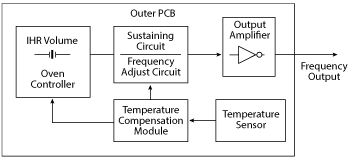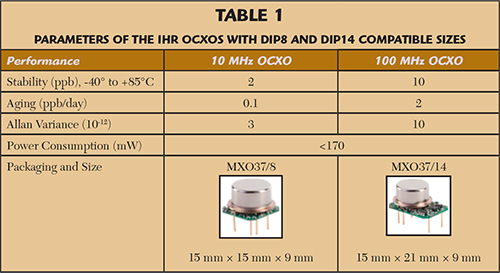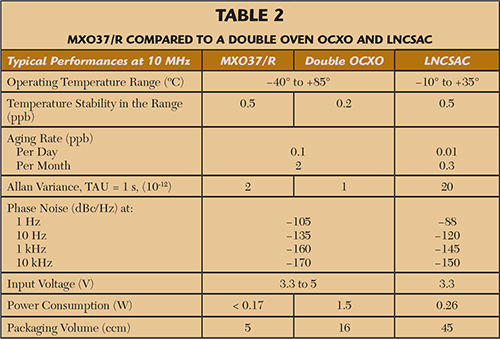
Modern trends in the development of high accuracy timing and frequency control systems are placing increased demands on the stability and phase noise of the reference oscillators. For battery supply applications requiring precise synchronization and timing in GPS denied environments such as underwater clocks, high-end mobile radio and portable test equipment, the requirement is for the best frequency stability along with the smallest size and lowest power consumption. Conventional oven controlled oscillators (OCXO) provide acceptable frequency stability and phase noise but consume too much (>1 W) power and cannot be considered adequate for these applications.
One of the most promising recent approaches has been the chip scale atomic clock technology (CSAC) that has a combination of the “atomic” long-term stability with the OCXO style packaging and very low power consumption (130 mW). However, the disadvantage of this approach is poor short-term stability (or Allan variance) determined by the temperature compensated crystal oscillator (TCXO) embedded in the CSAC structure that considerably restricts its wide use. This shortcoming was overcome with the low noise CSAC version (LNCSAC) that employed a miniature low power OCXO based on the internally heated resonator technology (IHR) of the TCXO. Incorporation in the atomic clock of the high stability crystal oscillator has ensured a radical improvement in its short-term stability; however, at the expense of significant increase in the size and doubling of the power consumption1.
Meanwhile recent improvements of the IHR technology have enabled the creation of new OCXO designs with considerably improved frequency stability, almost to the level of high-end conventional OCXOs and achieved with very low power consumption and a much smaller size. Significant improvement in the performance has become possible due to the minimization of two fundamental factors limiting frequency instability of the IHR oscillators. The first is the non-uniform heating of the crystal plate in the miniature oven structure enclosed in less than a 1 cm3 IHR holder, resulting in noticeable thermal gradients in the plate varying with the ambient temperature changes. The other factor affecting OCXO stability is the temperature sensitivity of the surrounding circuitry arranged outside the ovenized volume at ambient temperature conditions.

Figure 1 Structure of the IHR OCXO with temperature compensation circuitry.
Significant reduction of the causes of instability has required a new technique for frequency versus temperature stabilization. It assumes that besides physical minimization of temperature sensitivity of the IHR and the sustaining circuitry, the device can eliminate the remaining frequency deviations with the compensation circuitry, correcting the operating temperature and output frequency in accordance with ambient temperature changes. The structure of the new oscillator is schematically depicted in Figure 1.
The new OCXO design consists of the IHR (internally heated resonator with the crystal plate and oven controlled system integrated in the TO-8 vacuum holder) and the electronic circuitry arranged on the outer PC board. The circuitry, except the sustaining stages, electronic corrector and output amplifier, contains the external temperature sensor generating a voltage output linear with the ambient temperature changes. The voltage from the temperature sensor passes to the compensation module producing a correction bias on the oven controller and the electronic corrector minimizing the temperature error of IHR and temperature sensitivity of the sustaining circuitry.
Such a combination of the oven control and electronic compensation techniques has enabled the reduction of the temperature instability factors to almost “zero” enhancing the stability of the IHR devices near the level of double-oven OCXOs. The long-term frequency stability (aging) of the OCXOs is almost entirely determined by aging of the crystal resonator that is mostly caused by mechanical stresses and contamination on the crystal plate surfaces. To minimize the aging factors, the high-overtone crystal plates with small surface-to-volume ratio are utilized in the IHR construction. Together with a very clean manufacturing process, this ensures stability of 10 MHz oscillators to less than 0.1 ppb/day and 15 ppb/year aging rate.

Integration of the whole oven control system with the crystal plate inside the TO-8 resonator package and arrangement of the oscillator circuitry on outer PC board under the TO-8 base has enabled the creation of the smallest devices in this class with DIP8 and DIP14 compatible sizes and pins-out. Table 1 summarizes basic parameters of these OCXOs operating at 10 and 100 MHz frequencies.
The new IHR oscillators provide the temperature stability and aging similar to high-end conventional OCXOs consuming much lower power and occupying less than 2 cm3. Further improvement of the temperature stability and Allan variance has been achieved with the OCXO design enclosed in the 20 mm × 20 mm × 12.6 mm steel case. This packaging enables operation of the device in harsh environmental conditions and minimizes temperature mismatch between the resonator and the circuitry at non-uniform or transient ambient temperature. The temperature stability of the packaged MXO37/R model significantly exceeds that of the “packageless” MXO37/8 and MXO37/14 oscillators approaching the level of the double-oven OCXOs.

Table 2 shows the primary performance specifications of the MXO37/R oscillators in comparison to double-oven OCXOs and LNCSACs. The MXO37/R model yields somewhat to the double OCXOs in the temperature stability and Allan variance but has the same aging with much smaller size and lower power consumption. As compared with the LNCSAC, the IHR devices exhibit considerable advantages in most performance parameters except long-term stability where the atomic clocks are superiority.
The new generation of the IHR OCXO is well suited for various applications requiring high frequency stability of the reference oscillator with small size and low power consumption. Realized in the DIP8 and DIP14 compatible sizes, these oscillators provide high performance that was previously only available in high-end conventional OCXOs. Packaged in the 20 mm × 20 mm × 12.8 mm case, the IHR devices exhibit an unmatched combination of low power and small size with excellent frequency stability at the level of the double-oven OCXOs.
Although long-term stability of the IHR OCXOs is currently limited to 0.1 ppb/day rate for some applications, especially in harsh environmental conditions, they can be an attractive alternative to CSACs with the same or less power consumption and smaller size, providing better temperature stability, phase noise and Allan variance.
Reference
- Peter Cash, Dan Boschen, Ramesh Gandham and David Mailoux, “Low Noise Chip Scale Atomic Clock,” 2014 IEEE International Frequency Control Symposium.
Magic Xtal Ltd.
Omsk, Russia
www.magicxtal.com
